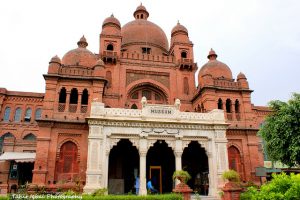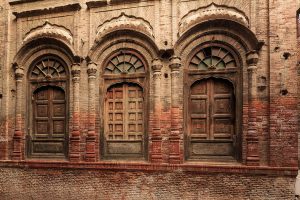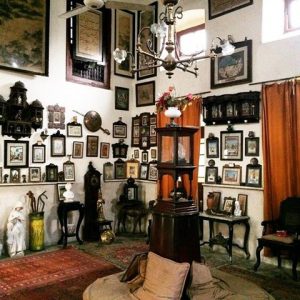Lahore City Tours
Lahore is Pakistan’s second largest city. It is widely considered the country’s cultural capital. The heart of Lahore is the Walled or Inner City, a very densely populated area of about one square kilometer. Founded in legendary times, and a cultural center for over a thousand years, Lahore has many attractions to keep the tourist busy. The Mughal and Sikh legacy survives in the Lahore Fort, Badshahi Mosque and Gurdwara, the Mall is lined with colonial-Gothic buildings from the British Raj, and the suburbs of Gulberg and Defence feature palatial mansions and trendy shopping districts.
Badshahi Masjid
 It is a known fact that the Mughal architecture is the most elegant manifestation of the building art of the Muslim world. This architectural style has been acknowledged as the blending of grace, strength and harmony.
It is a known fact that the Mughal architecture is the most elegant manifestation of the building art of the Muslim world. This architectural style has been acknowledged as the blending of grace, strength and harmony.
The amazing symmetry of the three giant white marble domes capping the many arches of the mosque is a marvel of harmony in masonry. It is the most striking piece of architecture in Lahore and its huge domes and minarets can be spotted from far off. This mosque was built by the great emperor Aurangzeb.
The design of the mosque is bound by conventions.it is a building of very strong and resolute character. Apart from its architectural magnificence the Badshahi Masjid is also one of the largest mosques in the world.
Lahore Fort
 The massive doors, great walls of the lahore fort, the throne room with its marble pavilion, the Diwan-e-Aam the court of public audience, the Sheesh Mahal, the Naulakha and the Moti Masjid peak eloquently of the days gone by. Intricate patterns of inlaid precious stones, carvings, mosaic tiles, murals against the background of rough tiles are a treat to the aesthetic eye.
The massive doors, great walls of the lahore fort, the throne room with its marble pavilion, the Diwan-e-Aam the court of public audience, the Sheesh Mahal, the Naulakha and the Moti Masjid peak eloquently of the days gone by. Intricate patterns of inlaid precious stones, carvings, mosaic tiles, murals against the background of rough tiles are a treat to the aesthetic eye.
It is one of the three great palaces forts built by the Mughals in south Asia.this fort, originally built by Ayaz and later rebuilt by the great Akbar has its own distinctive history and character. epoch making sessions were taken here which changed the history of this area and world. There are numerous myths and legends behind the various divans of the fort. You can feel them, sense them, provided you have an eye to see and an ear to listen. as emperor Jahangir put in his memories.
Shalimar Garden
 This romantic Mughal monument takes its name from the Ancient word Sholah Mah means (the light of the moon ). Amongst all the Mughal monuments, it stands out as an apostle of romanticism. It may have lost its glory to the ravages of time but it still retains an aura of romance that permeates all its corners.
This romantic Mughal monument takes its name from the Ancient word Sholah Mah means (the light of the moon ). Amongst all the Mughal monuments, it stands out as an apostle of romanticism. It may have lost its glory to the ravages of time but it still retains an aura of romance that permeates all its corners.
These gardens were laid out in 1637 A.D by emperor Shah Jehan. The design of the present day garden comprises of three terraces. The first is known as Farrah Bukhsh (bestowed of pleasure). While the second and third are collectively known as Faiz Bukhsh (bestowed of plenty). It is an enchanting piece of landscape where an imaginative gardener’s fancy has come into full bloom.
No pleasing intricacies intervene
No artful wilderness to perplex the scene,
Grove nods at grove,each alley has a brother,
And half the platform just reflects the other
No artful wilderness to perplex the scene,
Grove nods at grove,each alley has a brother,
And half the platform just reflects the other
Jahangir’s Tomb
 It is believed that this tomb was designed by Jahangir’s beloved wife Noor Jehan. However,it was built by his son Shah Jehan who had a great love for architecture.
It is believed that this tomb was designed by Jahangir’s beloved wife Noor Jehan. However,it was built by his son Shah Jehan who had a great love for architecture.
The building of the tomb with for tall minarets looks like a big jewel set in the heart of verdant garden,the profusion of marble ornamentation, magnificent exterior, tasteful decorated interior, expensive perspective of the landscape all indicate the excellence of the builder’s taste and craftsmanship.
we are no other than a moving row
Of visionary shapes that come and go
Round with this sun illuminated lantern held
In midnight by the master of the show
Of visionary shapes that come and go
Round with this sun illuminated lantern held
In midnight by the master of the show
Noor Jehan’s Tomb
 The real name of Noor Jehan was Mehrun Nisa begum.she was given the title of Noor Jehan (light of the world) when she was married to emperor Jahangir in 1611. Noor Jehan was the only empress whose name appeared on the Mughal coins. She died in 1645 A.D.
The real name of Noor Jehan was Mehrun Nisa begum.she was given the title of Noor Jehan (light of the world) when she was married to emperor Jahangir in 1611. Noor Jehan was the only empress whose name appeared on the Mughal coins. She died in 1645 A.D.
Eighteen years after Jahangir’s death and was buried near her husband’s tomb. She is said to have built her mausoleum during her lifetime. Her tomb originally was exquisitely embellished with glazed lime plaster bearing beautiful floral fresco painting, but time treated this building cruelly.
Today what remains is hardly enough to remind one of its original splendor.
upon my grave when i shall die,
No lamp shall burn nor jasmine lie,
No candle, with unsteady flame,
Serve as a reminder of my fame,
No bulbul chanting overhead
shall tell the world that i am dead.
No lamp shall burn nor jasmine lie,
No candle, with unsteady flame,
Serve as a reminder of my fame,
No bulbul chanting overhead
shall tell the world that i am dead.
Lahore Museum
 The Lahore museum is regarded as one of the oldest and the most authentic in Pakistan was built during the times of the British and opened to the public in 1894. Lahore museum has been constructed in the Mughal Gothic style the ceiling is decorated with Sadequain Pakistani artist to illustrate a line from one of Iqbal’s poem.
The Lahore museum is regarded as one of the oldest and the most authentic in Pakistan was built during the times of the British and opened to the public in 1894. Lahore museum has been constructed in the Mughal Gothic style the ceiling is decorated with Sadequain Pakistani artist to illustrate a line from one of Iqbal’s poem.
It is a treasure house containing unique materials of almost all ages displayed in several galleries Islamic Hindus an Jain wood caving and Islamic works such as illustrated manuscripts Korans rugs an metalwork paintings are arranged there are statures of Buddha in various postures including the priceless piece of hantine fasting Buddha and various pieces of sculpture of the Gandhara period moreover the valuable treasure of Lahore museum included collection of Mughal paintings, coins and another unique feature is the collection of stamps issued by the government of Pakistan during the past decades.
The walled city
 The walled city is located to the south of river Ravi, which once flowed along the walls of Lahore fort.In the past, access to the walled city was possible only through one of its imposing gates.which date back to the days of Akbar the great who held his court in Lahore for fourteen years.
The walled city is located to the south of river Ravi, which once flowed along the walls of Lahore fort.In the past, access to the walled city was possible only through one of its imposing gates.which date back to the days of Akbar the great who held his court in Lahore for fourteen years.
The walled area was accessible through twelve gates, built under his orders. Till the day of Ranjit Singh the ruler of Punjab, these gates were closed at night.the wall around old city was falling into decay when Ranjit Singh rebuilt it in 1812. He also surrounded it with a moat which was earth filled during the British period and fine gardens were laid out there.
The picturesque Bazaars of the walled city, its narrow streets multi-storied houses and incredible din fascinate the visitor. Wazir Khan’s Masjid of the Mughal period remains almost the only witness to the past splendor of the old city. It is also known as the architectural ornament of Lahore
Fakir Khana Museum
 Fakir Khana Museum, the largest antiques collection in south Asia, is the honor and pride of the well known Fakir Family whose vibrant history can be amazingly traced back hundreds of years. This Private family museum is basically inside an early 20th century house carrying a kaleidoscope of unimaginable pieces. From gems & stones, portraits & miniatures to original manuscripts of holy Quran and Relics of Islam including the relics of the Holy Prophet.
Fakir Khana Museum, the largest antiques collection in south Asia, is the honor and pride of the well known Fakir Family whose vibrant history can be amazingly traced back hundreds of years. This Private family museum is basically inside an early 20th century house carrying a kaleidoscope of unimaginable pieces. From gems & stones, portraits & miniatures to original manuscripts of holy Quran and Relics of Islam including the relics of the Holy Prophet.
It is a place full of history, memories and treasures. Every single artifact at Fakir Khana Museum has a story to tell. Entering the arches of the Fakir Khana Museum you truly get to know that not only this family is the proud bearer of the relics and the antiques collection but it’s also a part of an eventful history.


